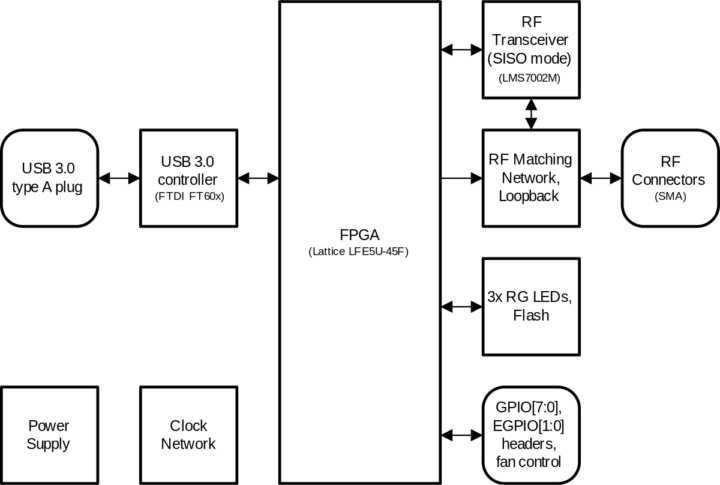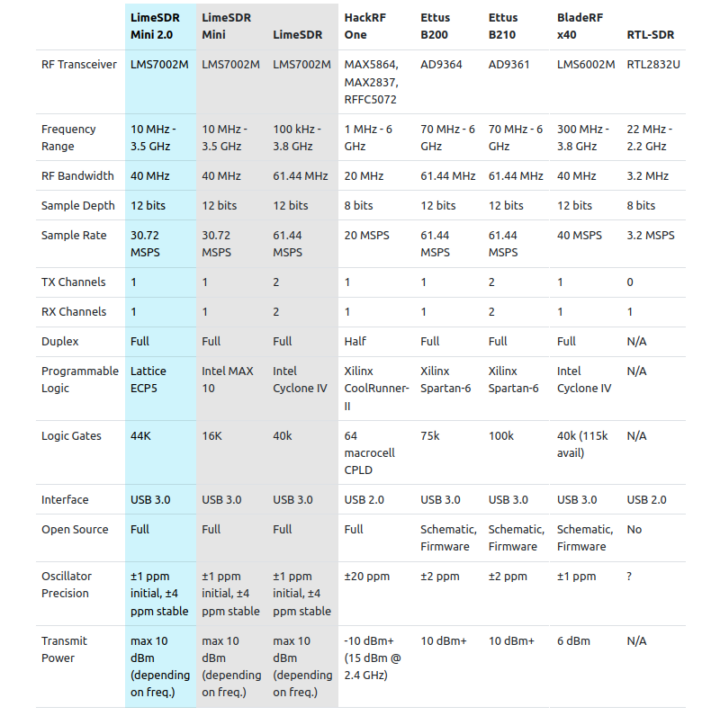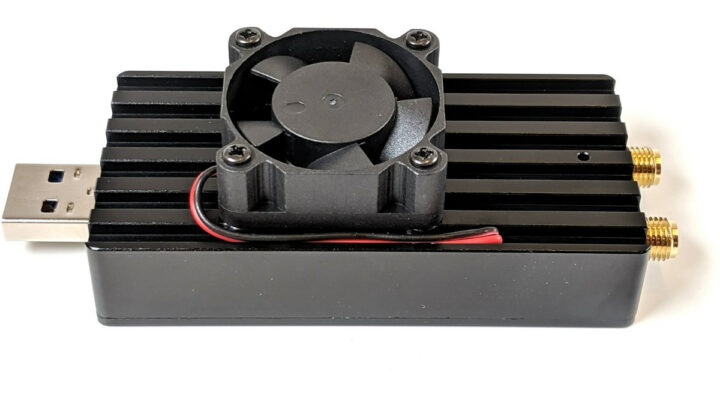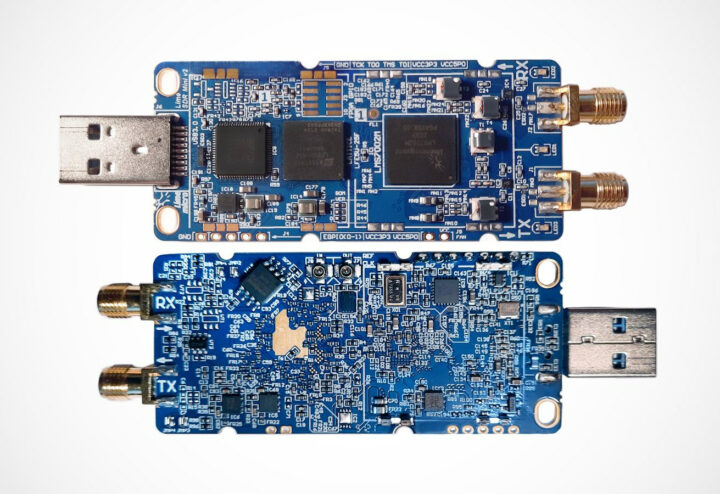The LimeSDR Mini is an open-source hardware full-duplex USB SDR board based on Intel Altera Max 10 Altera FGPA that was introduced in 2017 on Crowd Supply and raised close to $2 million US dollars. Since it has been used in various projects including digital TV transmitters.
Lime Microsystems is now back on Crowd Supply with the similar-looking LimeSDR Mini 2.0 replacing the MAX 10 FPGA with 16K logic gates with a more powerful and capable Lattice Semiconductor ECP5 FPGA with 44K logic gates while keeping the company’s LMS7002 RF transceiver.
LimeSDR Mini 2 specifications:
- FPGA – Lattice Semi ECP5 (LFE5U-45F) with 44K logic gates, 108 sysMEM blocks (18kb), 1,944 Kb embedded memory, 351 Kb distributed RAM bits
- Storage – 4 MB flash memory for data; 2x128KB EEPROM for RF transceiver MCU firmware and data
- RF
- Lime Microsystems LMS7002M RF transceiver
- Tx & Rx SMA connectors
- Frequency range – 10 MHz to 3.5 GHz
- RF bandwidth – 40 Mhz
- Sample Rate – 30.72 MSp/s with 12-bit sample depth
- Power Output (CW): up to 10 dBm depending on the frequency
- USB – 1x USB 3.0 port via FTDI FT60x controller chip
- Expansion – 8-pin FPGA GPIO header
- Misc – 3x dual color LEDs, JTAG
- Power – USB or external power supply
- Dimensions – 69 mm x 31.4 mm

The company will make the LimeSDR Mini 2.0 open-source hardware, and release the schematics and PCN layout, manufacturing files (e.g., Gerbers, drill, and part placement files), FPGA gateware, host software, documentation, and toolchain configuration before going to production.
Beyond the higher number of logic gates, Lime Microsystems lists two other advantages of ECP5 against the MAX10 FPGA: first, it is more readily available (the main reason why LimeSDR Mini 2.0 was designed), and second, it is supported by plenty of open source tools and has a great community of developers that are gathered around ECP5 boards such as OrangeCrab, Radiona ULX3S, or LUNA.
 The comparison table above shows how the LimeSDR Mini 2.0 fares against the earlier LimeSDR and LimeSDR Mini boards, as well as competing solutions such as HackRF One, Ettus B200/B210, BladeRF x40, or even the entry-level RTL-SDR USB dongle.
The comparison table above shows how the LimeSDR Mini 2.0 fares against the earlier LimeSDR and LimeSDR Mini boards, as well as competing solutions such as HackRF One, Ettus B200/B210, BladeRF x40, or even the entry-level RTL-SDR USB dongle.
LimeSDR Mini 2.0 is compatible with the same enclosures and antennas as the original LimeSDR Mini, and like its predecessor can be used in a variety of RF projects including Amateur digital TV broadcast, satellite ground station, streaming FM to the Internet, spectrum-scanning jammer and controller for drones, bit pattern generator aligned with the SDR data stream, digital audio broadcast, and more. But the new USB SDR dongle should be able to support an even wider range of applications thanks to the extra logic gates.
The LimeSDR Mini was launched for as low as $99 (Early Bird) and a standard price of $139, but the LimeSDR Mini 2.0 is significantly pricer at $399 due to the higher price for the Lattice ECP5 FPGA, and most likely the current semiconductor shortage and high inflation. Optional accessories include acrylic or aluminum metal cases, a multi-band 4G/3G/2G monopole antenna, and a Grove Starter Kit with various sensors and actuators. Shipping adds $8 to the US and $18 to the rest of the world, and the first 1,000 backers should expect their rewards to ship by mid-October 2022, while those would pledge later would have to wait at least until Q1 2023.


Jean-Luc started CNX Software in 2010 as a part-time endeavor, before quitting his job as a software engineering manager, and starting to write daily news, and reviews full time later in 2011.
Support CNX Software! Donate via cryptocurrencies, become a Patron on Patreon, or purchase goods on Amazon or Aliexpress






Ouch, that price difference is brutal. LFE5U-45F should only add maybe $30 to the BOM cost in singles, let alone in volume.
I was interested in the original one but couldn’t decide as I didn’t want to buy something to gather fust again, regretted it a couple of times, and now… What should I say…
FPGAs in this range have gone from $30 a pcs to $230 a pcs over the past year, so the difference is not that far off…
That’s just the scalper price though, if you are lucky enough to be in the right place on the backorder queue the price is no different to before.
For what I can use this device?
Judging from your question probably for same as me… Nothing 😸
Actually you can use it to receive and transmit radio signals, but it is not a traditional hardware radio it’s a so called software defined radio, it directly feeds a part of the radio spectrum into an analog to digital converter, all the demodulation (and modulation) happens in software, and thus for me not really of much use if I can’t find a ready made example…
I’m saddened to say, that that greatly disappointed me. Not only because of price, phasing out much more powerfull LimeSDR, but also it’s the first time where they’re trying that nasty marketing tricks to hide that there are better competitors on the market. When LimeSDR originally debuted on the marked 6 years back or so, they were unbeatable. But now there are many constructions even outperforming theirs. LimeSDR was still the one because of price, but now – it is discontinued, in its place there’s way limited LimeSDR Mini 2.0, with a pretty high price jump and nearly no significant… Read more »
Aliexpress is full of SDR stuff, seems very popular.
I have 2 of them. And it’s for sale now. If you want, you can contact by e-mail.